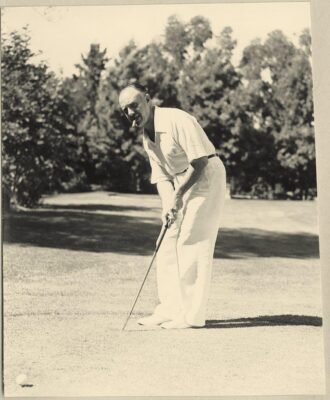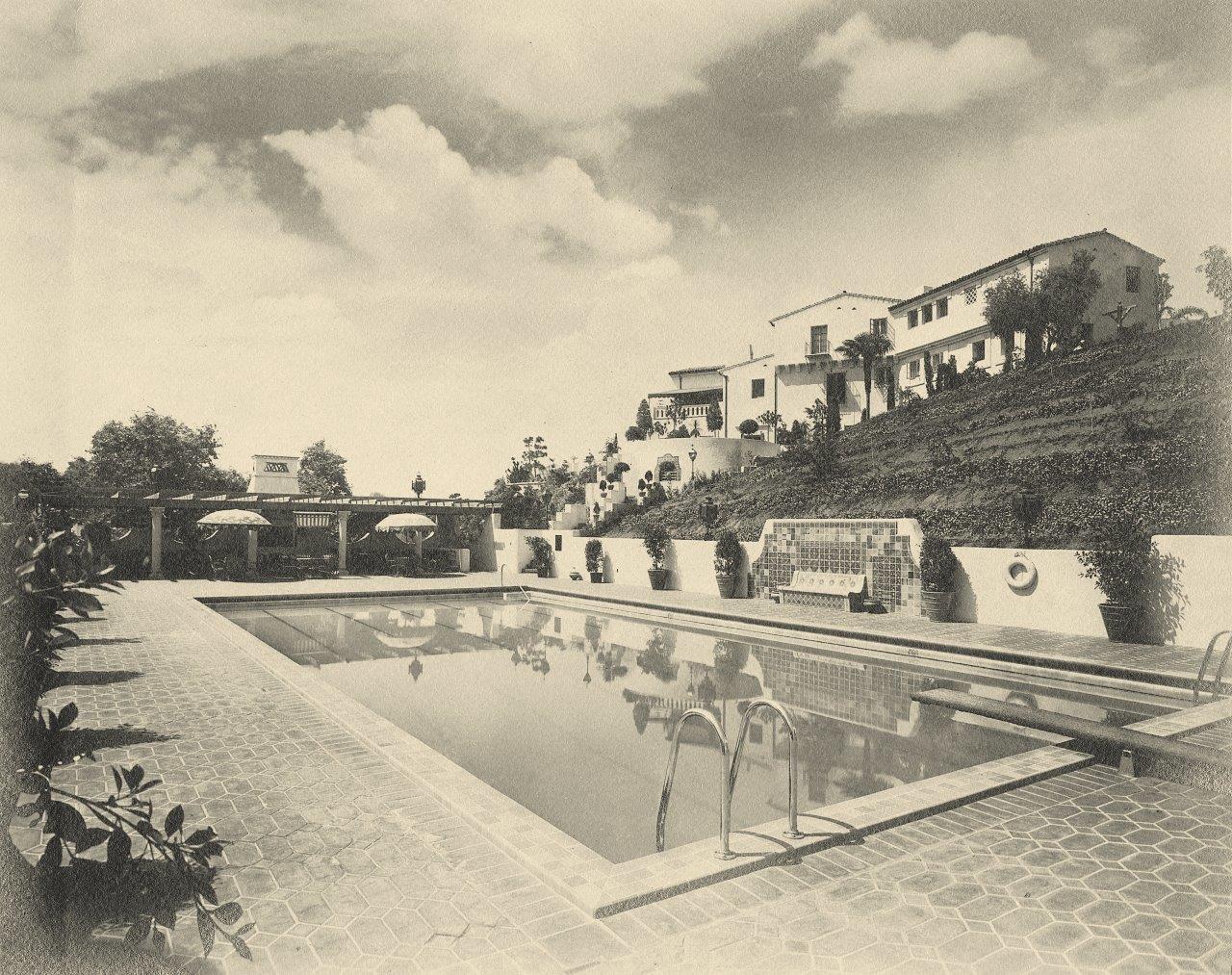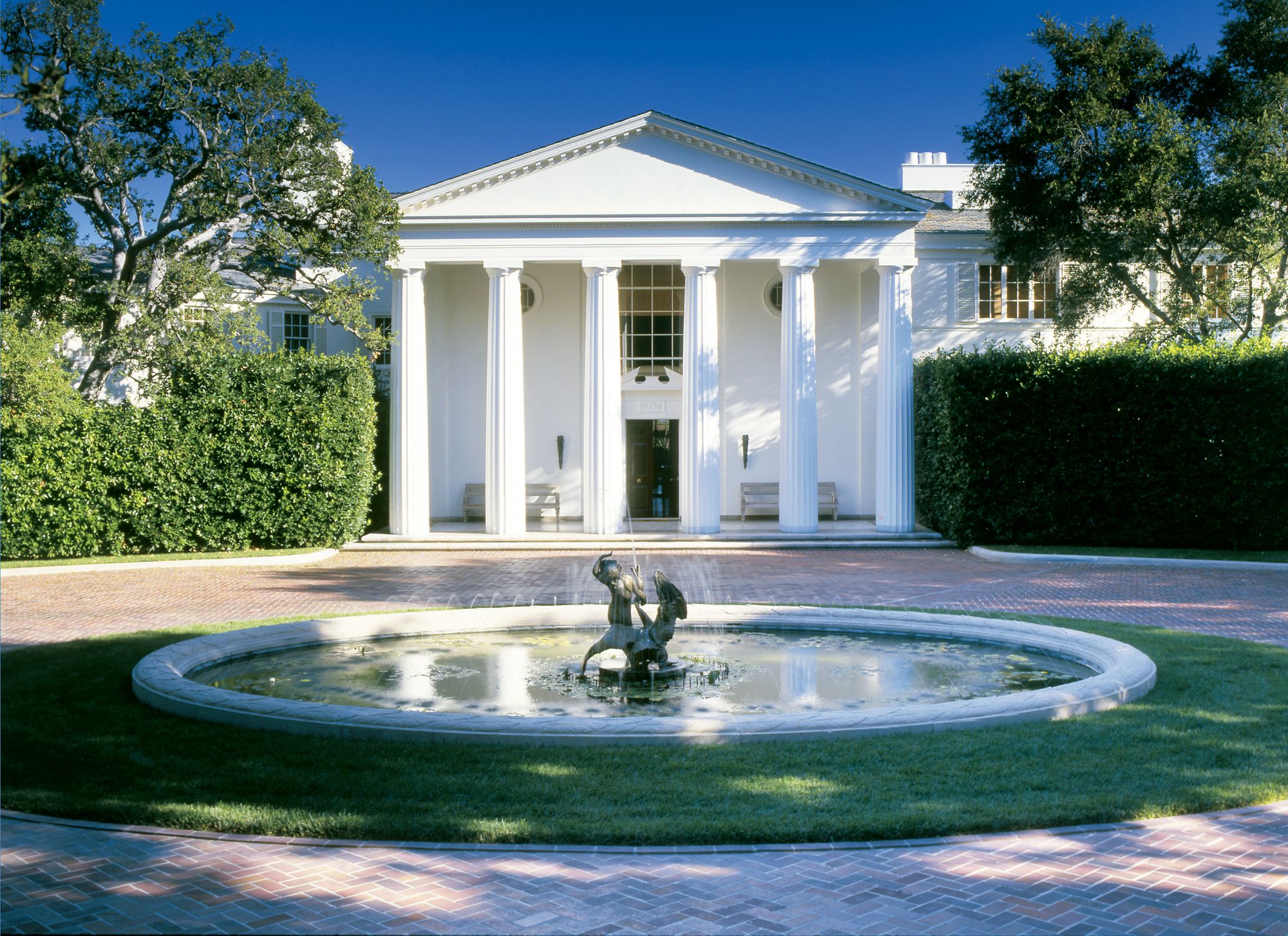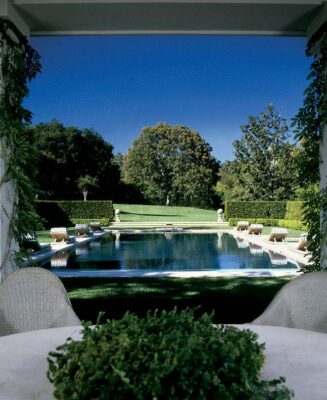
Jack Warner golfing. Photo Credit: Tim Street-Porter.
During the golden age of Hollywood – which ran from the late 1920s to the advent of television and the disintegration of the studio system in the early 1950s – movie studio czars lived in impressive mansions set amidst handsome gardens to flaunt their wealth and power and to hold highly publicized parties with hundreds of guests.
No studio czar’s residence, before or since, has ever surpassed in size, grandeur, or sheer glamour than the Jack Warner Estate on Angelo Drive in Benedict Canyon.
In a supreme show of confidence – or ego – Warner didn’t emulate English aristocracy or fading silent-movie stars like Douglas Fairbanks Senior and Mary Pickford by giving his estate an impressive-sounding name. His own name – Jack Warner – was impressive enough.
Warner also took a very different approach to building his estate. Most movie stars and studio executives constructed their grand estates all at once. Warner, however, created his Angelo Drive estate step-by-step over a decade. His home grew and changed as his business and personal life grew and changed.
By now, it’s a cliché to say that the various studio heads during the Golden Age of Hollywood were all larger-than-life characters, whose talent – or perceived lack of same – has been endlessly lampooned in widely circulated anecdotes ad stories. When these stories are boiled down the results tend to establish a ranking among the moguls. David O. Selznick, Sam Goldwyn, Harry Cohn, and Darryl F. Zanuck might have been quirky and obsessive, but they received a certain respect as filmmakers. Louis B. Mayer, “Uncle” Carl Laemmle Senior, and Jesse Lasky might not have been the greatest filmmakers, but they were showmen: executives who managed the rough-and-tumble film factories that were Hollywood in its glory days. So on down the list. And then there was Jack Warner.
Jack had a matter to be addressed: his home. Before they were married, Ann Alvarado Page told Jack that she was not going to move into “another woman’s home.”
Fixing that problem was easy. Warner already owned a fine estate in Benedict Canyon. In 1926, he had purchased four acres on Angelo Drive, next door to Harold Lloyd’s Greenacres. In April 1928, Warner, Irma, and Jack Jr. moved into their new fifteen-room Spanish Colonial Revival–style mansion. The house and gardens had cost $250,000. With his newfound wealth in the late 1920s and early 1930s, Warner enlarged his estate. He purchased several adjacent empty acres on which he built a nine-hole golf course. He bought—and demolished—the mansion next door to enlarge the grounds of his estate.
Warner really didn’t want to leave the very fashionable Angelo Drive location. He must have struck a deal with Ann. He’d completely rebuild the ten-year-old Spanish-style mansion and its grounds. That would blot out any trace of the discarded Irma, and it would give Jack and Ann a new showplace to celebrate their wealth and marriage.
His landscape architect was Florence Yoch, who worked on some of Los Angeles’s greatest estates and designed movie sets, including the set for Tara in Gone with the Wind (1939).
In the 1920s, Coate had worked in Pasadena, San Marino, Beverly Hills, Holmby Hills, and Bel-Air, and he could give his clients virtually any style: Spanish, Monterey, Tudor, Regency, or Colonial Revival. He could skillfully mix different styles on one property. He designed the much-admired David O. Selznick house on Summit Drive in Beverly Hills in 1933. He was architect for both the Gary Cooper residence and the Frank Capra residence in Brentwood in 1936.
None of those commissions, of course, compared to the reconstruction of the Jack Warner mansion. Coate selected a Georgian Revival style with a front portico with six Doric columns. Why did Warner select this style? Maybe it was a nod to Ann Warner’s Southern background. Or maybe the Georgian Revival implied generations of wealth and social status. Whatever the reason, the house was a stunning sight that revealed itself only at the last minute after visitors entered the Angelo Drive gates and drove up the winding driveway.

The completed Spanish Colonial Revival. Photo Credit: Tim Street-Porter.
This particular neoclassical mansion was not a home; it was a private museum. And a party palace. Thanks to interior and furniture designer William Haines. The Warners’ mansion was Haines’s largest commission to date—his friends Ann Warner and costume designer Orry-Kelly had insisted on hiring him—and it launched him into the Hollywood stratosphere. Just as no one
dared refuse a Jack Warner invitation to a party, no one could ignore the person to whom he had entrusted over $1 million for the interior design of his mansion. Nor could they ignore the beautiful home this openly gay former movie idol created.
Haines made a special trip to Europe specifically to find antique furnishings for the Warner mansion. He brought back a late-19th-century gilt Venetian mirror and a neoclassical chandelier for the oval ladies’ sitting room where Ann and her friends gathered for their own intimate parties. He found 18th-century English paneling, George III mahogany armchairs, an early George III lady’s writing desk, and two sets of 18th-century Chinese-painted wallpaper panels for the main living room. For the dining room, he brought back early-19th-century French wallpaper, George III mahogany urns and pedestals, and a Carrara marble and lapis lazuli mantelpiece for the fireplace.
Haines’s custom furniture—coffee tables, armchairs, ottomans—was usually low, which set off the rooms, the Warners, and their guests to best advantage and made them seem larger, grander, and more elegant and important. He also designed his furniture to support conversation, creating chairs and ottomans that swiveled. The entire sofa in the library/screening room swiveled into the best viewing position for the movie screen, and then returned to its normal position when the movie was over.
The restraint of the neoclassical mansion was extended by landscape architect Yoch onto the nine acres of grounds, which she constructed between 1935 and 1937. Yoch, who had been working since 1918, had also provided landscape designs for David O. Selznick and George Cukor, as well as for five movie sets. Like Haines, Yoch was openly gay. Her business partner in the Yoch and Council landscape architecture firm was her lover and lifelong companion Lucille Council. Yoch combined her extensive knowledge of Europe’s landscape architecture history and design with restraint, eclecticism, and deliberately deceptive scale in her work.
She first bulldozed the existing gardens. With a budget of around $100,000, Yoch designed new formal and informal gardens, two guesthouses, a nursery with three greenhouses, and a service garage complete with gasoline pumps. Yoch, of course, kept the nine-hole golf course. How many moguls could boast of such a recreational luxury? Or boast of a neighbor (Harold Lloyd) who also had a nine-hole golf course, making it possible for them to erect a temporary stairway over the estate walls so their guests could play eighteen holes?
But it was the grounds themselves that excited the greatest admiration. “[Yoch] bowled over guests with grand effects through large-scale planning and earthworks,” declared the book Landscaping the American Dream: The Gardens and Film Sets of Florence Yoch. “She combined the example of French models, which she admired for their graceful handling of crowds, with less severe, earlier sources like the Italian party villas of Frascati, Lucca, and the Veneto. With wide steps, languorous walks, leaning trees, and low walls she emphasized the horizontal spaces, gently accented with upright urns and plants. On the narrow verges of the large public scenes were shaded benches and secret doorways, giving opportunities for quiet interludes.”

The Warner Estate. Photo Credit: Tim Street-Porter.
Yoch added three turns to the long driveway and lined it with large, arching sycamores to make the estate seem even larger and more expansive, and the arrival sequence all the more impressive. The front of the mansion had extensive garden vistas, a large terrace with a fountain of seahorses ridden by cupids that evoked the grandeur of 18th-century France without ostentation, and a smaller, circular fountain. A broad, graduated stairway led through the various formal gardens and terraces. A grand stone staircase lined with statuary led up to the North Garden with its lawns, shrubs, and semicircular baroque columns around a small pool.
Bordering each terrace and major amenity on the grounds were lush, tall trees that both framed the spaces and created a sense of privacy. Yoch also used tall hedges set close to each other to delineate spaces, provide privacy, and make a garden space seem larger. Entertaining was vital to the Warners, and most of their outdoor entertaining was poolside. Yoch gave the swimming pool a neoclassical pavilion and two large terraces—one where guests could lounge and another that served as an outdoor kitchen, complete with a barbeque and even a soda fountain. She redesigned the stairway leading from the pool to the house and the library/screening room:
it began with low stucco walls shaded by an overhanging tree, became more formal brick walls, and finally became neoclassical columns and urns that provided an immediate connection to the Georgian mansion. A double stone stairway on the opposite side of the pool led into lawns and gardens.
Throughout the stately grounds, Yoch created expansive lawns, terraces with ornamental urns and statues, formal gardens, arbors, a variety of fountains, waterfalls and water cascades, winding pedestrian paths, stone bridges, and hillside forests. “The Warner estate became a new Olympus, where the rulers of Hollywood paraded amid splendors both European and decidedly American,” it was said.
The final step in creating Jack and Ann Warner’s showplace was the selection of paintings for the main rooms of the house. The couple may have been artistically illiterate, but they “knew what they liked.” Ann needed something just right for the living room mantle. Earl Stendahl, a noted art dealer to the Hollywood stars in the 1930s and 1940s, was summoned to Angelo Drive. He procured a Degas from the famous Wildenstein Galleries in New York. But, alas, it was too small. Next, Wildenstein Galleries in Paris shipped out a Gauguin. It was delivered to Ann, who thought it perfect.
But Jack was having none it. The scene was a barnyard in Brittany and there in the center were … pigs. Even though Jack routinely ignored his Jewish heritage, certainly when it came to eating pork, something about it bothered him. He was not going to have pigs over the mantel in his living room.

The Warner Estate. Photo Credit: Tim Street-Porter.
The painting was returned to Wildenstein, who was told why Jack Warner had rejected it. Wildenstein replied that if he had known that was the problem, he would have had Gauguin paint cows instead. Next, the gallery sent Warner a Seurat, painted on wood. It might have worked had Warner not picked it up to have a look and promptly dropped it, cracking it in two.
The painting was returned, repaired, and promptly sold to David O. Selznick, who seems never to have been aware of its treatment at Warner’s hands. In the 1940s, Warner commissioned portraits of both Ann and himself from surrealist painter Salvador Dalí, who was residing in Hollywood. It is said that one of the most fabled parties at the Warner estate was for the unveiling of Dalí’s portrait of Ann. Actor Paul Henreid, who was there, remembered it as a soiree for three hundred. At the grand moment, with Dalí present, a curtain was drawn back and the portrait revealed, a strong likeness of Ann with more than a hint of elegance. Supposedly, gasps were heard when guests perceived the small figure of a monkey in a cage, which bore a likeness to none other than Jack.
After the Warners completed their showplace, the parties started and didn’t let up for many years. They were elaborate affairs, where everything was perfect. By comparison, the 1920s parties at Douglas Fairbanks Sr. and Mary Pickford’s rather simple Pickfair—a drink, quick dinner, a movie, then out the door—were amateurish.
In 1967, at age seventy-five, Warner sold his ownership share in Warner Bros. He died in 1978 at age eighty-six.
After her husband’s death, Ann continued to live at their estate until her death in 1990. By remaining there throughout the 1970s and 1980s, she preserved the Warner Estate at a time when other properties were being heavily altered or subdivided into building lots.
Today, the Warner Estate is the largest intact estate from the Golden Age of Hollywood.
